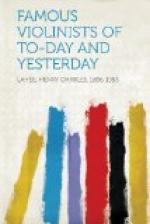In 1846 came Sivori, and in 1848 Remenyi, both artists whose desire to please their audiences took them far from the path of the highest musical standard. It may be said with truth that the country was hardly ready for musicianship of the highest quality, and even in 1872, when Wieniawski came with the great pianist and composer, Rubinstein, the two were accepted on their reputation rather than on their merits, which were understood by a comparatively small proportion of their audiences.
Although several violinists endeavoured to copy Paganini’s style, or at least to learn as much as possible from hearing and seeing him play, there was only one, excepting Catarina Calcagno, who received direct instruction from him, and on whom his mantle was said, by his admirers, to have fallen. That one was Camillo Sivori, born at Genoa, June 6, 1817.
[Illustration: CAMILLO SIVORI]
The connecting link between Sivori and Paganini began very early in the career of the former. Indeed it is said that the excitement of his mother, on hearing Paganini play at a concert, caused the premature birth of the future disciple of the great artist. Marvellous stories are told of Sivori’s infancy. At the age of eighteen months, before he had ever seen or heard a violin player, he continually amused himself by using two pieces of stick after the manner of the violin and bow, and singing to himself. It is fair to say that similar precocity in other children has not always resulted in virtuosity. A case might be cited of a very young person who amused himself by inverting a small chair, and imagining that he was a street organist, but he grew to maturity without adopting that profession.
At two years of age, the account continues, he cried out lustily for a violin, and when his father, reduced to submission by the boy’s importunity, bought him a child’s violin, he at once began to apply himself, morning, noon, and night, to practising on this instrument, and without any aid he was able in a short time to play many airs he had heard his sisters play or sing. His renown spread through Genoa, and he was invited everywhere. At concerts and parties he was placed upon a table to play, and he was frequently called upon to perform before the king and the queen-dowager. He must have been a most wilful and embarrassing child, for the account goes on to say that he would not enter a church unless he heard music; but on the other hand, if he did hear music he insisted on going in, or else he would scream and make a terrible scene.




